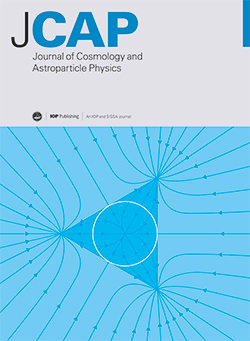Gravitino thermal production, dark matter, and reheating of the Universe
IF 5.3
2区 物理与天体物理
Q1 ASTRONOMY & ASTROPHYSICS
Journal of Cosmology and Astroparticle Physics
Pub Date : 2025-01-21
DOI:10.1088/1475-7516/2025/01/079
引用次数: 0
Abstract
We present a full one-loop calculation of the gravitino thermal production rate, beyond the so-called hard thermal loop approximation, using the corresponding thermal spectral functions in numerical form on both sides of the light cone. This framework requires a full numerical evaluation. We interpret our results within the framework of a general supergravity-based model, remaining agnostic about the specifics of supersymmetry breaking. In this context, assuming that gravitinos constitute the entirety of the dark matter in the Universe imposes strict constraints on the reheating temperature. For example, with a gluino mass at the current LHC limit, a maximum reheating temperature of Treh ≃ 109 GeV is compatible with a gravitino mass of m3/2 ≃ 1 TeV. Additionally, with a reheating temperature an order of magnitude lower at Treh ≃ 108 GeV, the common gaugino mass M1/2 can range from 2 to 4 TeV within the same gravitino mass range. For much higher values of M1/2, which are favored by current accelerator and cosmological data in the context of supersymmetric models, such as M1/2 = 10 TeV, and for m3/2 ≃ 1 TeV the reheating temperature compatible with the gravitino dark matter scenario is 107 GeV. If other dark matter particles are considered, the reheating temperature could be much lower.引力子的热产生,暗物质,以及宇宙的再加热
我们提出了引力微子热生成率的完整一环计算,超越了所谓的硬热环近似,在光锥两侧使用数值形式的相应热谱函数。这一框架需要全面的数值评估。我们在基于超引力的一般模型框架内解释我们的结果,对超对称破缺的具体细节保持沉默。在这种情况下,假设引力素构成了宇宙中全部的暗物质,就会对再热温度产生严格的约束。例如,在当前大型强子对撞机极限的胶素质量下,Treh ≃ 109 GeV 的最高再热温度与 m3/2 ≃ 1 TeV 的引力素质量是相容的。此外,当再热温度比 Treh ≃ 108 GeV 低一个数量级时,在相同的引力子质量范围内,普通高次元质量 M1/2 可以在 2 到 4 TeV 之间。对于更高的 M1/2 值,目前的加速器和宇宙学数据都倾向于超对称模型,例如 M1/2 = 10 TeV,而对于 m3/2 ≃ 1 TeV,与引力微暗物质情景相容的再热温度是 107 GeV。如果考虑其他暗物质粒子,再加热温度可能会低得多。
本文章由计算机程序翻译,如有差异,请以英文原文为准。
求助全文
约1分钟内获得全文
求助全文
来源期刊

Journal of Cosmology and Astroparticle Physics
地学天文-天文与天体物理
CiteScore
10.20
自引率
23.40%
发文量
632
审稿时长
1 months
期刊介绍:
Journal of Cosmology and Astroparticle Physics (JCAP) encompasses theoretical, observational and experimental areas as well as computation and simulation. The journal covers the latest developments in the theory of all fundamental interactions and their cosmological implications (e.g. M-theory and cosmology, brane cosmology). JCAP''s coverage also includes topics such as formation, dynamics and clustering of galaxies, pre-galactic star formation, x-ray astronomy, radio astronomy, gravitational lensing, active galactic nuclei, intergalactic and interstellar matter.
 求助内容:
求助内容: 应助结果提醒方式:
应助结果提醒方式:


